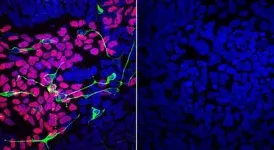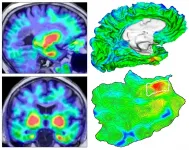(Press-News.org) Catnip and silver vine have been known as cat attractant plants. Cat lovers use dry leaves of these plants and toys stuffed with the leaves to give joy to their pet cats. But how does this work? What is the biological significance of the responsive behavior? A research group at Iwate University, Nagoya University, Kyoto University, and University of Liverpool found that the behavior had more practical reasons than getting euphoria.
"The first appearance of silver vine ("Matatabi" in Japanese) as a cat attractant in literature in Japan dates back to more than 300 years ago. A folklore Ukiyo-e drawn in 1859 shows a group of mice trying to tempt some cats with a smell of silver vine. Still, benefits of the cats' response had remained unknown." says Prof. Masao Miyazaki of Iwate University, a leader of the research project.
The research group first identified the active ingredient of silver vine that induces the response. They isolated substances from extract of silver vine leaves and administrated each of them to cats to examine the response. The experiment revealed that nepetalactol, a novel substance, most strongly induces the characteristic behavior.
"We applied nepetalactol to laboratory paper filters and tested with eighteen laboratory and seventeen feral cats. They displayed the typical response to silver vine. We also tested the substance with larger, non-domestic cats (jaguar, Amur leopard, and Eurasian lynx). They showed a similar reaction. We concluded nepetalactol is responsible for the typical feline reaction to silver vine," said Reiko Uenoyama, the paper's first author.
The second important finding by the researchers is the biological mechanism of the response by feline animals to silver vine. They hypothesized that the μ-opioid system, which is associated with euphoric effects in humans, is activated with the plant. "We tested β-endorphin levels before and after nepetalactol-induced response in cat blood. We found that silver vine activates the nervous system that is responsible for the euphorigenic reaction," said Miyazaki.
Does this mean cats play with silver vine to get euphoria? Alternatively, does silver vine has another function to cats? The research group believed that the plant has another biologically important function as the reaction was already shown in feline animals when they evolved from other species about 10 million years ago.
"On the basis of some reports that nepetalactone, the feline attractant in catnip, has mosquito repellent activity, we thought that the response allows cats to transfer plant's nepetalactol or nepetalactone on their fur for protection against mosquitoes. This led to a strong hypothesis when we found the mosquito repellent activity of nepetalactol." said Uenoyama.
To examine whether cats purposefully transfer nepetalactol, the research group placed paper filters with nepetalactol on different parts of the cat cage (floor, walls and ceiling). Although cats rubbed their faces and heads on the paper regardless of the place of the nepetalactol paper, they did not show the typical rolling when the paper was placed on a wall or ceiling. When cats rubbed against the nepetalactol paper, the substance was transferred to their faces and heads, indicating that the most important function of rubbing behavior is to apply the chemical to these parts of feline fur.
"Next, we tested the mosquito repellent property of nepetalactol on cats. We counted the numbers of mosquitoes landing on cat heads with and without application of nepetalactol. The mosquitoes landed less on the nepetalactol heads. To see whether mosquitoes react the same in a more natural setting, we compared the mosquito reaction between cats that responded to silver vine leaves and nonresponsive cats. Mosquitoes avoided the responsive cats. From these results, we found that the cats' reaction to silver vine is chemical defense against mosquitoes, and perhaps against viruses and parasitic insects. This was the most significant finding of our study," said Miyazaki.
Miyazaki and his colleagues see many possibilities to use the findings in research and practical application. "Why is this reaction limited to cats? Why don't non-feline animals react to the plant? To find answers, we want to identify the gene responsible for the reaction. The findings of this study may be used in various applications, including development of new mosquito repellant products."
INFORMATION:
The research is published by Science Advances on January 20, 2021.
Journal Article
Reiko Uenoyama, Tamako Miyazaki, Jane L. Hurst, Robert J. Beynon, Masaatsu Adachi, Takanobu Murooka, Ibuki Onoda, Yu Miyazawa, Rieko Katayama, Tetsuro Yamashita, Shuji Kaneko, Toshio Nishikawa, and Masao Miyazaki. The characteristic response of domestic cats to plant iridoids allows them to gain chemical defense against mosquitoes.
Science Advances.
DOI: 10.1126/sciadv.abd9135
Research Contact
Professor Masao Miyazaki
Laboratory of Biomolecular Science, Department of Biological Chemistry and Food Sciences, Faculty of Agriculture, Iwate University. 3-18-8 Ueda, Morioka, Iwate 020-8550, JAPAN
TEL&FAX: +81-(0)19-621-6154
Email: mmasao@iwate-u.ac.jp
Scientists at the University of Southampton and University of Edinburgh have developed a flexible underwater robot that can propel itself through water in the same style as nature's most efficient swimmer - the Aurelia aurita jellyfish.
The findings, published in Science Robotics, demonstrate that the new underwater robot can swim as quickly and efficiently as the squid and jellyfish which inspired its design, potentially unlocking new possibilities for underwater exploration with its lightweight design and soft exterior.
Co-author Dr Francesco Giorgio-Serchi, ...
Researchers at the National Institutes of Health have discovered a new genetic disorder characterized by developmental delays and malformations of the brain, heart and facial features. Named linkage-specific-deubiquitylation-deficiency-induced embryonic defects syndrome (LINKED), it is caused by a mutated version of the OTUD5 gene, which interferes with key molecular steps in embryo development. The findings indicate that the newly identified pathway may be essential for human development and may also underlie other disorders that are present at birth. The information will help scientists better understand such diseases--both common ...
Researchers have developed an automated method that can track the development of harmful clumps of TAU protein related to Alzheimer's disease in the brain, according to work involving 443 individuals. The method revealed that TAU primarily emerged in an area of the brain called the rhinal cortex before spreading elsewhere, suggesting that targeting TAU here could potentially slow the progression of Alzheimer's disease. The buildup of toxic amyloid-beta and TAU proteins is responsible for many of the symptoms and damage to neurons seen in Alzheimer's disease. However, current therapies have shown reduced efficacy, at least in part because the therapies were administered long ...
A new Northwestern University study reaffirms the importance of getting a good night's sleep.
By examining fruit flies' brain activity and behavior, the researchers found that deep sleep has an ancient, restorative power to clear waste from the brain. This waste potentially includes toxic proteins that may lead to neurodegenerative disease.
"Waste clearance could be important, in general, for maintaining brain health or for preventing neurogenerative disease," said Dr. Ravi Allada, senior author of the study. "Waste clearance may occur during wake and sleep but is substantially enhanced during deep sleep."
The ...
Rubbing against catnip and silver vine transfers plant chemicals that researchers have now shown protect cats from mosquitoes. The results also demonstrate that engaging with nepetalactol, which the study identified as the most potent of many intoxicating iridoid compounds found in silver vine, activates the opioid reward system in both domesticated felines and big jungle cats. While nepetalactol had been previously identified, these studies directly illuminate its extremely potent effect on cats. And by revealing the biological significance of well-known feline behaviors, ...
Methamphetamine overdose deaths surged in an eight-year period in the United States, according to a study published today in JAMA Psychiatry. The analysis revealed rapid rises across all racial and ethnic groups, but American Indians and Alaska Natives had the highest death rates overall. The research was conducted at the National Institute on Drug Abuse (NIDA), part of the National Institutes of Health.
Deaths involving methamphetamines more than quadrupled among non-Hispanic American Indians and Alaska Natives from 2011-2018 (from 4.5 to 20.9 per 100,000 people) overall, with ...
BOSTON -- While deaths related to heart disease have declined among older people, studies suggest that death rates among younger patients have remained stagnant or increased slightly. To understand what factors put younger individuals at higher risk of premature coronary heart disease (CHD), researchers from Brigham and Women's Hospital and the Mayo Clinic analyzed more than 50 risk factors in 28,024 women who participated in the decades-long Women's Health Study. Notably, women under 55 with type-2 diabetes had a tenfold greater risk of having CHD over the next two decades, with lipoprotein insulin resistance ...
Over the past 20 years, scientists have been developing metamaterials, or materials that don't occur naturally and whose mechanical properties result from their designed structure rather than their chemical composition. They allow researchers to create materials with specific properties and shapes. Metamaterials are still not widely used in everyday objects, but that could soon change. Tian Chen, a post-doc at two EPFL labs - the Flexible Structures Laboratory, headed by Pedro Reis, and the Geometric Computing Laboratory, headed by Mark Pauly - has taken metamaterials one step further, ...
What The Study Did: This observational study examined how COVID-19-related government-mandated closures and restrictions were associated with changes in mobility and the spread of COVID-19 in Nigeria.
Author: Daniel O. Erim, M.D., Ph.D., M.Sc., of Parexel International in Durham, North Carolina, is the corresponding author.
To access the embargoed study: Visit our For The Media website at this link https://media.jamanetwork.com/
(doi:10.1001/jamanetworkopen.2020.32101)
Editor's Note: Please see the article for additional information, including other authors, author contributions and affiliations, conflict of interest and financial disclosures, and funding and support.
# ...
Suppose Smokey the Bear were to go on a tear and start setting forest fires instead of putting them out. That roughly describes the behavior of certain cells of our immune system that become increasingly irascible as we grow older. Instead of stamping out embers, they stoke the flames of chronic inflammation.
Biologists have long theorized that reducing this inflammation could slow the aging process and delay the onset of age-associated conditions, such as heart disease, Alzheimer's disease, cancer and frailty, and perhaps even forestall the gradual loss of mental acuity that happens to nearly everyone.
Yet the question of ...




